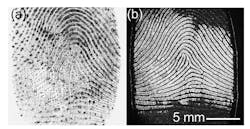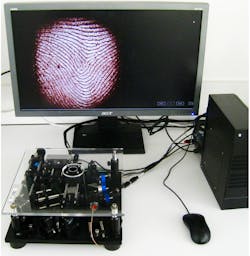Imaging system reads fingerprints at subdermal level
A new tool developed by researchers at the PSL Research University (Paris, France; www.psl.eu/en), the Polish Academy of Sciences (Warsaw, Poland; www.pan.pl), and Norwegian University of Science (Gjøvik, Norway; www.ntnu.edu), as described in the research paper “Compact and Mobile Full-Field Optical Coherence Tomography Sensor for Subsurface Fingerprint Imaging (bit.ly/VSD_FNGPR),” images fingerprints at the subdermal level. According to the researchers, this new method overcomes challenges to accurate fingerprinting like moisture or particulate matter, equipment damage, and even artificial fingerprints.
Skin layers around 200 to 400 µm beneath the outer layer compose an internal fingerprint of live cells called the “viable epidermis.” These cells have the same topography of the outer skin layer on a fingerprint and, if imaged with a technique called full-field optical coherent tomography (FF-OCT), can generate a fingerprint scan.
Scanning at this depth also images sweat ducts not only used as additional markers for individual fingerprints, but whose absence in an image will indicate clearly a fake fingerprint placed over a fingertip.
FF-OCT imaging is used for biomedical applications like imaging skin, brain tissue, gastrointestinal walls, and corneas or practical applications such as detecting counterfeit currency. The imaging devices used for these applications are large and expensive. The device developed by the researchers, however, is lightweight, portable, and inexpensive.
The device consists of a Q-2A750-CXP camera from Admiec (Eindhoven, Netherlands; www.adimec.com) with 2 MPixel CSI2100 CMOS sensor from ams (Premstaetten, Austria; www.ams.com); an AIMC-2100-9S51 microcomputer with Advantech (Milpitas, CA, USA; www.advantech.com) with a Cyton-CXP4 CoaXPress frame grabber from BitFlow (Woburn, MA, USA; www.bitflow.com); and M850L3 LEDs, lenses, mirrors, and beamsplitters from Thorlabs (Newton, NJ, USA; www.thorlabs.com).
In operation, a person places their hand on a 30 × 30 × 1 cm piece of plexiglass on top of the camera, with a 5 cm-diameter hole cut for the lens to see through. This captures the entire hand in a single frame. The LEDs beneath the plexiglass provide 900 W of spatially incoherent homogenous illumination at the 850 nm wavelength. Beamsplitters and reflectors direct the returning light onto the image sensor.
The system captures images at 720 fps, which according to the researchers puts a high demand on data transfer between camera and microcomputer. The addition of the Cyton-CXP4 frame grabber provides a maximum data transfer speed of 25 Gbps. Computational imaging techniques derive FF-OCT images from the raw camera images, with 50 raw images used per FF-OCT image to improve signal to noise ratio. It takes 285 ms to acquire a single FF-OCT image.
The researchers shipped the new FF-OCT sensor to the TUBITAK premises of the Scientific and Technological Research Institution of Turkey (Kavaklidere, Ankara, Turkey; www.tubitak.gov) where a total of 7020 fingerprint images, with 13 FF-OCT images generated per fingerprint, were taken from 585 subjects with six unique fingerprints per subject. Conventional fingerprint imaging devices also took fingerprints.
The accuracy rate for capturing fingerprints from the FF-OCT images, compared with the accuracy rate for capturing fingerprints using traditional methods, is similar enough to prove the new FF-OCT device can capture fingerprints as effectively as traditional methods.
About the Author

Dennis Scimeca
Dennis Scimeca is a veteran technology journalist with expertise in interactive entertainment and virtual reality. At Vision Systems Design, Dennis covered machine vision and image processing with an eye toward leading-edge technologies and practical applications for making a better world. Currently, he is the senior editor for technology at IndustryWeek, a partner publication to Vision Systems Design.

